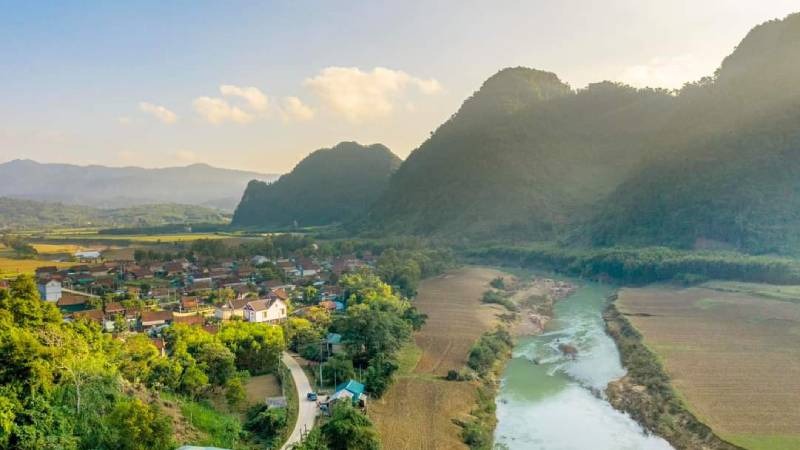Chi tiết tin - Quảng Bình (Tiếng Anh)
Tan Hoa village in Quang Binh: rising from rural hardship to "best tourism village in the world"
Once an impoverished rural village, Tan Hoa in Quang Binh Province used to grapple with floods every year. But today it has been dubbed the "best tourism village in the world". Tan Hoa in Minh Hoa District is around 75 km from the Son Doong Cave, which is the world's largest in Phong Nha - Ke Bang National Park.
Surrounded by spectacular limestone karst mountains and the Rao Nan river which resembles a jade silk ribbon snaking through peaks, Tan Hoa offers a peaceful heaven. From Quy Dat town, it’s about 8km to Tan Hoa which offers scenic beauty. However, its unique terrain also puts Tan Hoa at risks when flooding season comes from mid-September to mid-November every year.

Tan Hoa tourism village in the central province of Quang Binh
he historic flooding in 2010 with water rising to 12 metres inundated local houses, and forced people to evacuate to nearby karst mountains. Properties swept away and poultry and crops damaged, local residents returned home empty-handed, and tried to rebuild their lives from almost zero. To live safely along with floods, Tan Hoa villagers created floating houses of about 20 sq. m from wood with empty barrels underneath and poles to hold the houses in place.
During 2012-2020, Oxalis Adventure tour operator, through the “Tu Lan Race” event, called for financial support to build nearly 200 floating houses for poor families.
The houses were constructed with stainless steel frame, walls and roof covered with corrugated iron sheets, and large enough for a family of at least six people and necessities to survive during monsoon season. As of October 2023, more than 620 floating houses had been built for Tan Hoa locals with financial support from domestic individuals and organisations.
Now, floating houses are not only a place for Tan Hoa locals to live in but also a way for them to earn a living. With support from Oxalis, 10 Tan Hoa households transformed their floating houses into climate-adaptive lodging facilities. Costing some 150 million VND (6,100 USD), each homestay offers 26-40 square metres of space for 1-3 people, with a private bathroom.
The UNWTO’s recognition has affirmed the local authorities’ resolve to develop Tan Hoa into an excellent weather-adaptive tourism model in Vietnam and the Southeast Asia at large. This is a global initiative to highlight villages and tourism sites’ efforts to preserve and promote community-based values, making contributions to realising sustainable development goals through tourism.
It was honored with the "Best Tourism Villages 2023" title by the World Tourism Organization (UNWTO), after an evaluation of 260 applications from 60 countries. Its transformation began circa 2014 when it opened its doors to tourism, with a focus on exploring the Tu Lan Cave system.
Tu Lan is an enchanting cave system with six wet and dry caves known for their stalactites, stalagmites and unique features. From 2013 to 2023, the village has welcomed approximately 63,000 visitors in total. In the past three years alone, the village has witnessed remarkable growth in visitor numbers, surging from fewer than 4,000 a year to over 9,000.
Visitors to Tan Hoa can also partake in thrilling morning adventures with all-terrain vehicles (ATVs), a popular activity among tourists alongside cave exploration.
Over the past years, local residents have engaged in tourism activities to help sustainably reduce poverty. With support from businesses, Tan Hoa has become a weather-adaptive tourism village with many unique and typical tourism products.
Launched in 2021, the Best Tourism Villages by UNWTO initiative is part of the UNWTO Tourism for Rural Development Programme. The programme works to foster development and inclusion in rural areas, combat depopulation, advance innovation and value chain integration through tourism, and encourage sustainable practices.
The villages are evaluated under nine key areas, namely cultural and natural resources; promotion and conservation of cultural resources; economic sustainability; social sustainability; environmental sustainability; tourism development and value chain integration; governance and prioritisation of tourism; infrastructure and connectivity; and health, safety, and security.
Source: https://en.cand.com.vn/
- Camping Son Doong cave at three stunning stops (11/03/2024)
- Four-day expedition of DJ Martin Garrix inside world's largest cave Son Doong (06/03/2024)
- Journey to find the legendary Truong Son mark (27/02/2024)
- Phong Nha - Ke Bang National Park targets 3 million tourists by 2030 (19/02/2024)
- Unveiling the hidden world of Hung Thoong (Quang Binh Province) (16/01/2024)
- Vietnam’s majestic Son Doong Cave stars in Planet Earth III (09/01/2024)
- A trip to biosphere reserve in Quang Binh province (05/01/2024)
- 10 New Asian records for Vietnamese cuisine and specialty gifts (27/12/2023)
- Lost iPhone returned to British tourist (27/12/2023)
- Quang Binh targets 5 million tourists in 2024 (21/12/2023)



